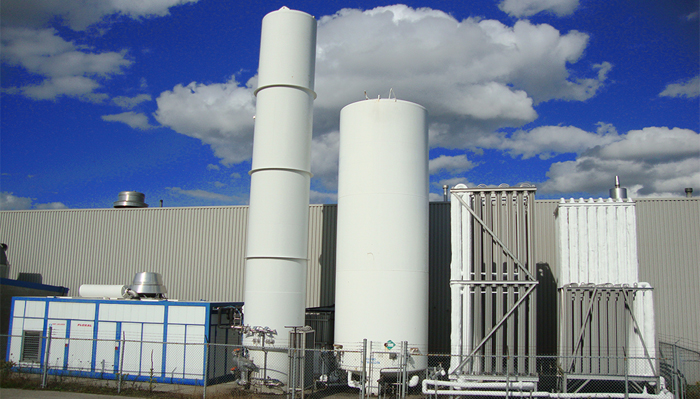Product Category
Special requirements for LNG cryogenic storage tanks
Date: Mar 18, 2020

Natural gas is recognized as a clean, environmentally friendly and safe high-quality energy source. After liquefied natural gas, the volume is reduced by about 600 times, which brings great benefits to storage. Liquefied natural gas (LNG) is stored in cryogenic storage tanks.
1.low temperature resistance
The boiling point of LNG under normal pressure is -160 ° C. LNG selects the cryogenic and normal pressure storage method, which lowers the temperature of natural gas below the boiling point, so that the operating pressure of the cryogenic storage tank is slightly higher than normal pressure. Compared with the high pressure and normal temperature storage method, it can greatly reduce the tank wall thickness and improve safety performance.
Therefore, LNG requires pressure vessels to have good cryogenic resistance and excellent cold storage performance.
2.High safety requirements
Because the cryogenic liquid is stored in the storage tank, once an accident occurs in the cryogenic storage tank, the refrigerated liquid will volatilize a lot, and the gasification amount is about 300 times that in the original refrigerated state, and an air mass that will automatically detonate is formed in the atmosphere.
Therefore, API, BS and other regulations require that the storage tank adopt a double-walled structure and use the blocking concept. When the first-layer tank leaks, the second-layer tank can completely block the leaked liquid and evaporated gas to ensure storage. Safety.
3.Special materials
The inner tank wall of a cryogenic storage tank requires cryogenic resistance. Generally, materials such as 9Ni steel or aluminum alloy are used, and the outer tank wall is prestressed reinforced concrete. 4. Strict insulation measures
4. Strict insulation measures
Since the temperature difference between the inside and the outside of the storage tank can reach 200 ° C, to keep the temperature inside the tank at -160 ° C, the cryogenic storage tank must have good cold storage performance, and high-performance cold storage materials should be filled between the inner and outer tanks. The bottom of the tank must have sufficient pressure-bearing properties.
5, good seismic performance
The seismic requirements of general buildings are to crack and not fall under specified seismic loads. In order to ensure the safety of pressure vessels under unexpected loads, storage tanks must have good seismic performance. For LNG storage tanks, it is required that they will not fall or crack under the specified seismic load.
Because of this, the selected construction site generally avoids the seismic fracture zone. Before construction, an earthquake test is performed on the storage tank, and the structural performance of the storage tank under dynamic conditions is analyzed to ensure that the tank body is not damaged under the earthquake intensity.
1.low temperature resistance
The boiling point of LNG under normal pressure is -160 ° C. LNG selects the cryogenic and normal pressure storage method, which lowers the temperature of natural gas below the boiling point, so that the operating pressure of the cryogenic storage tank is slightly higher than normal pressure. Compared with the high pressure and normal temperature storage method, it can greatly reduce the tank wall thickness and improve safety performance.
Therefore, LNG requires pressure vessels to have good cryogenic resistance and excellent cold storage performance.
2.High safety requirements
Because the cryogenic liquid is stored in the storage tank, once an accident occurs in the cryogenic storage tank, the refrigerated liquid will volatilize a lot, and the gasification amount is about 300 times that in the original refrigerated state, and an air mass that will automatically detonate is formed in the atmosphere.
Therefore, API, BS and other regulations require that the storage tank adopt a double-walled structure and use the blocking concept. When the first-layer tank leaks, the second-layer tank can completely block the leaked liquid and evaporated gas to ensure storage. Safety.
3.Special materials
The inner tank wall of a cryogenic storage tank requires cryogenic resistance. Generally, materials such as 9Ni steel or aluminum alloy are used, and the outer tank wall is prestressed reinforced concrete.

Since the temperature difference between the inside and the outside of the storage tank can reach 200 ° C, to keep the temperature inside the tank at -160 ° C, the cryogenic storage tank must have good cold storage performance, and high-performance cold storage materials should be filled between the inner and outer tanks. The bottom of the tank must have sufficient pressure-bearing properties.
5, good seismic performance
The seismic requirements of general buildings are to crack and not fall under specified seismic loads. In order to ensure the safety of pressure vessels under unexpected loads, storage tanks must have good seismic performance. For LNG storage tanks, it is required that they will not fall or crack under the specified seismic load.
Because of this, the selected construction site generally avoids the seismic fracture zone. Before construction, an earthquake test is performed on the storage tank, and the structural performance of the storage tank under dynamic conditions is analyzed to ensure that the tank body is not damaged under the earthquake intensity.
Send Your Inquiry
We not only provide a good product, but also provide high quality service. If you are interested in our products,
you can contact us in the following ways.
you can contact us in the following ways.







